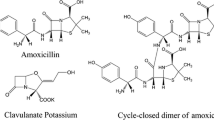Abstract
Purpose. To predict the degree of crosslinking from formaldehyde-stressed hard gelatin capsules (HGCs) using near-infrared spectrophotometry (NIR).
Methods. HGCs were exposed to a 150 ppb atmosphere of formaldehyde for 2.25,4.60,9.42, 16.0 and 24.0 hours. The capsules were filled with fresh amoxicillin, placed in a 90° conical reflector cone, and scanned in a NIR spectrophotometer. Principal component regression (PCR) was employed to analyze the spectra of the intact capsules. Dissolution profiles were then obtained for each experimental group.
Results. The dissolution of amoxicillin from the capsules at pH 1.2 was found to decrease with increasing time of exposure to the formaldehyde atmosphere. A set of principal components (PCs) was formed by a linear combination of the absorbance values at each wavelength scanned. A good correlation was established (r2 = 0.963) when PC values from the NIR spectra of the HGCs were regressed against percentage of amoxicillin dissolved at 45 minutes, at pH 1.2. Water content of the capsules was found to be the largest determinant in the variation between HGC spectra at each exposure time.
Conclusions. NIR spectrophotometry, combined with PCR, was successful at not only predicting dissolution of HGCs exposed to formaldehyde, but also at determining which wavelengths contributed most to spectral variation of these stressed HGCs.
Similar content being viewed by others
REFERENCES
G. A. Digenis, T. B. Gold, and V. P. Shah. J. Pharm. Sci. 83:915–921 (1994).
B. E. Jones. In Hard Capsules-Development and Technology; K. Ridgway, (ed.), The Pharmaceutical Press, London, 1987, pp. 1–12.
B. T. Palerno and S. C. McMillion. U.S. Patent 2 578 943, 1951.
E. A. Swinyard and W. Lowenthal. In Remington's Pharmaceutical Sciences, 18th edition; A. R. Gennaro, (ed.), Mack, Eaton, Pennsylvania, 1990, p. 1306.
G. A. Digenis and T. B. Gold. Pharm. Res. 11:S146, PT 6064 (1994).
E. Doelker and A. C. Vial-Bernasconi. S. T. P. Pharma. 4:298–306 (1988).
H. Mohamad, R. Renoux, S. Aiache, and J.-M. Aiache. S. T. P. Pharma. 2:531–535 (1986).
H. Mohamad, R. Renoux, S. Aiache, J.-M. Aiache, and J.-P. Kantelip. S. T. P. Pharma. 2:630–635 (1986).
H. Mohamad, J.-M. Aiache, R. Renoux, P. Mougin, and J.-P. Kantelip. S. T. P. Pharma. 3:407–411 (1987).
A. Martin. In Wilson and Gisvold's Textbook of Organic Medicinal and Pharmaceutical Chemistry, 9th edition, Jaime N. Delgado and W. A. Remers, Eds., J. B. Lippincott Co., New York, 1991, p 157.
T. B. Gold, S. L. Smith, and G. A. Digenis. Pharm. Dev. Tech. 1:21–26 (1996).
S. K. Taylor, F. Davidson, and D. W. Ovenall. Photogr. Sci. Eng. 22:134–138 (1978).
K. Albert, B. Peters, E. Bayer, U. Treiber, and M. Zwilling. Z. Naturforsch. 41b:351–358 (1986).
K. Albert, E. Bayer, A. Worsching, and H. Vogele. Z. Naturforsch. 46b:385–389 (1991).
M. S. Kamat, R. A. Lodder, and P. P. DeLuca. Pharm. Res. 6:961–965 (1989).
R. G. Buice, Jr., T. B. Gold, R. A. Lodder, and G. A. Digenis. Pharm. Res. 12:161–163 (1995).
R. A. Lodder, M. Selby, and G. M. Hieftje. Anal. Chem. 59:1921–1930 (1987).
R. A. Lodder and G. M. Hieftje. Appl. Spectrosc. 42:556–558 (1988).
J. K. Drennen and R. A. Lodder. J. Pharm. Sci. 79:622–627 (1990).
S. Belman. Anal. Chim. Acta. 29:120–126 (1963).
J. W. G. Smith, G. E. de Grey, and V. J. Patel. Analyst 92:247–252 (1967).
Carstensen, J. T. and Rhodes, C. R. Drug Dev. Ind. Pharm. 19:1811–1814 (1993).
Chavetz, L., Hong, W-H., Tsilifonis, D. C., Taylor, A. K., and Philip, J. J. Pharm. Sci. 73:1186–1187 (1984).
J. E. Jackson. A User's Guide to Principal Components, John Wiley & Sons, Inc., New York, 1991, pp. 3–30.
R. G. Buice, Jr., T. B. Gold, R. A. Lodder, and G. A. Digenis. Pharm. Res. 12:S36 (1995).
Author information
Authors and Affiliations
Rights and permissions
About this article
Cite this article
Gold, T.B., Buice, R.G., Lodder, R.A. et al. Determination of Extent of Formaldehyde-Induced Crosslinking in Hard Gelatin Capsules by Near-Infrared Spectrophotometry. Pharm Res 14, 1046–1050 (1997). https://doi.org/10.1023/A:1012105412735
Issue Date:
DOI: https://doi.org/10.1023/A:1012105412735



